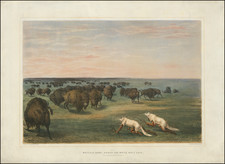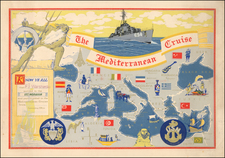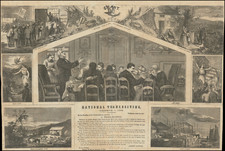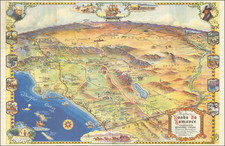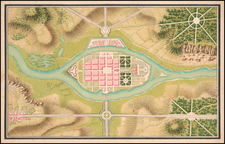Drawn By An American Rasputin -- The Most Magnificent Exhibition of California's Golden Oranges, Lemons &c. Ever Displayed!
Lively promotional broadside image, drawn by "American Rasputin" Carl Browne, promoting the Riverside, California Exhibit at the Southern California Citrus Fair, held in the Winter of 1888.
The image was drawn and published by Browne in his irregularly published Los Angeles Weekly "Cactus" as an Extra!, in early 1888. The image is a fine early example of Browne's artwork, his first of several careers, after moving west from Springfield, Illinois to San Francisco in 1869.
The broadside is one of the few surviving artifacts of the first Southern California Citrus Fair to be held in Los Angeles, held in conjunction with the newly formed Los Angeles Chamber of Commerce.
In the earliest years, Browne would become both a noted panorama artist and newspaper illustrator and publisher, as well as an early labor activist / agitator, with ties to the Anti-Cooley League and Workingmen's Party. After moving to Los Angeles, he published the Weekly Cactus, Los Angeles' first illustrated weekly newspaper, which began publishing in February 1883, for which he also served as editor, artist and manager. During this period, Browne referred to himself as the "Nast of the Pacific."
Browne would move on to fame as national labor agitator, early aviation pioneer, con artist, and charlatan.
Carl Browne-- An American Rasputin?
The artist of this view, Carl Browne (1849-1914) seems to have had a very colorful existence. Beginning as an artist in San Francisco and later Los Angeles, Browne seems to have segued into a career as a publisher, labor organizer, con artist, early aviation pioneer and charlatan.
As noted in "An American Rasputin"
Trained as a commercial house painter, Calisthenes “Carl” Dryden Browne (1849-1914) adapted his skill with a paintbrush to produce gigantic oil paintings on popular themes, beginning in 1869 with The Lord’s Supper, followed by Yosemite Valley, the Franco-Prussian War, and other spectacles. For six months in 1886, Browne rented a San Francisco theater not far from Market Square where he exhibited a panorama entitled Battle of Gettysburg, charging a small admission fee. Although no images survive, it has been described as a series of panels that formed a circle around the audience. On various nights Browne appeared alongside the paintings to entertaining the pubic with oratory that was part history, part religion, and part his own personal mythology.'
Not surprisingly, the charismatic speaker became active in politics, working for the United States Labor Party, the Workingmen’s Party, and in the spring of 1892, elected a delegate to the People’s Party convention in Omaha, Nebraska. In preparation, Browne painted 14 gigantic scenes, 7 ¼ x 14 feet each, on canvas that could be rolled and transported to the July convention where he spoke for three hours alongside his paintings, “prepared as object lessons to inform those who have not devoted time and thought to this movement of the people … the causes, aspirations and hopes of this people’s party.”
* * *
The Los Angeles Times called Carl Browne a blackmailer, liar, fraud, swindler and editor [who descended as] a swarm of devouring locust on the rapidly flourishing city of Los Angeles.” Elsewhere he is simply labeled a charismatic cartoonist or P.T. Barnum with a pen. What are we to make of this artist who obtained national stature, both good and bad?
While in San Francisco, Browne became active in politics as an active member there of the Workingmen's Party. Browne launched a radical weekly newspaper which he edited and for which he drew political cartoons, The Open Letter.
A short summary of Browne's life as an artist in Los Angeles appears in Art in Los Angeles "Before 1900": Part I (pp 53-54), which noted:
The Panorama building [in Los Angeles] soon, however, fell upon evil days with the swift deflation of the boom, and by the summer of the next year, 1888, was in the hands of Carl Browne, self-styled "Nast of the Pacific," after [Thomas] Nast, famous contemporary cartoonist and quick-sketch artist. Browne was connected with the Los Angeles humorous weekly Cactus , and on the evening of July 3, 1888, entertained fellow craftsmen in a novel fashion for a newspaperman. After a look at the cyclorama, Siege of Paris, an adjournment was made to the Panorama annex where Browne showed his valuable collection of paintings numbering about one hundred, most of them life-size copies of the old masters. After the lecture, refreshments Were brought in and finally Browne, by a demonstration of rapid painting of the Yosemite Valley, proved that he was indeed the Nast of the Pacific.
The Cactus sketches by Browne are for the most part political Cartoons, to us obscure in theme and drawn in a stiff and angular manner, quite unattractive today but then being popularized by the great Nast. There are, however, some good drawings of local events and places: a circus parade passing down Spring street in May, 1882, Round House park, a Santa Monica beach scene, os- triches scattering their keepers by well-aimed kicks (their kick can be as powerful as that of a mule) , and latest scenes from Inglewood, Glendale, San Fernando Valley and other rapidly growing centers.
After leaving a trail of disappointment in Los Angeles, Browne rose to national prominence when he served as "Chief Marshal" in the "Commonweal of Christ" army of Jacob S. Coxey in 1894. "Coxey's Army" marched on Washington, D.C., to demonstrate the plight of the country's unemployed and to demand a massive federally financed program of road construction to improve employment. The protest ended in a shambles, with Coxey and Browne arrested for walking on the capitol lawn.
Thereafter, Browne found himself in the Utopian colony of Freedom, Kansas with his wife Marne (the daughter of Jacob S. Coxey), claiming to be an inventor from Calistoga, California, where he quickly set about to perfect a commercial flying machine based on "The Carl Dryden Browne patient-applied-for principle of rotary winged wheels." Within a few months he constructed a wooden model of his invention. Browne's overall plans, and presumably those of the colony, were to build a flying- machine factory, one that would provide "employment to all those needing jobs in the Middle-West," and to sell these machines "so cheap as to soon supercede the bicycle for home use. On a Sunday in October, 1900, nearly a thousand people jammed the colony grounds to witness the laying of the cornerstone for the flying-machine factory. Although the colonists apparently completed a small factory building, they did not produce a single flying machine. Browne could not perfect his invention and money, always in short supply at Freedom, never materialized for the project. Brown and his wife, for unknown reasons, left Freedom about 1902.
Thereafter, Browne relocated to Calistoga, California, where he founded an irregularly-published news sheet devoted to the his pro-labor cause. While his aviation career should have been finished, Browne apparently continued on for another decade. In The Pleasantville Press (New Jersey), November 26, 1913, the following article appeared:
ADMIRAL OF THE AIR -- INVENTOR OF “OCTOPLANE” VISITS THE CAPITAL.
He Is a Mild, Blue-Eyed, Somewhat Ragged Man of Sixty-Five Years, Always an Enthusiast—Some times Called “Crank."
Carl Dryden Browne, agitator, artist, write, orator, resident of many jails, and finally Inventor of an “octoplane,” which he believes will solve the problem of stability, was in Washington a few days ago. A mild, blue eyed, somewhat ragged man of sixty-five years, always an enthusiast, frankly a lover of the first page column. Gentle as a woman, and yet he has fought policemen club for club. He was dragged bellowing from the steps of the capitol in 1894 in the disguise of the Goddess of Liberty—a lank, hairy armed virago-like goddess. He published the first illustrated daily newspaper on the Pacific coast and the second in the United States. He outmatched Ignatius Donnelly in a trial of wits and managed Dennis Kearney, the rebel of San Francisco's sand lots. His story runs back to the middle ages of the United States.
“Folks call me a crank," he said on Capitol hill. “Perhaps I am. I never made any money at it, but I have lived a full life.”
Printer and painter, he left his home in Springfield, Ill. in 1869, when he was twenty-one years old and went to California. In 1877 he walked out of his studio on Mission Street, San Francisco, to hear Dennis Kearney, then just beginning his anti-Chinese agitation. That day he threw in his lot with Kearney. Together they published “The Open Letter,” illustrated by Browne, largely handwritten, and published by a sort of a mimeograph process. The only other illustrated daily in America was the New York Grapich. Browne wrote Kearney’s speeches. He was jailed as often as Kearney.
As Kearney’s manager, he accepted Gen. Benjamin Butler's Invitation and took Kearney to Boston in 1878 for Butler’s campaign. On the retreat they spoke from the capitol steps at Washington. That caused the passage of John Sherman’s act, under which he was arrested on the same steps sixteen years later. In Chicago he be came a chum of Albert Parsons, later hanged as the leader of the Haymarket bomb throwers.
“Parsons was a dreamer and enthusiast,” said Browne, "but never a dynamiter. "By 1882 he had taken part in every political movement that finds record. Ignatius Donnelly—the man who Baconlzed Shakespeare and “found” the lost continent of Atlanta—read the resolutions of the silver convention held at Chicago that year. Browne was a silver delegate, but he “forgot.”
“Wrong,” he shouted from the floor. “The basis of all value is land.”
Worsted in repartee, Donnelly had the convention adjourned. Jacob Stelcher Coxey and Cyclone Davis and Jerry Simpson and Annie Diggs and a host of other odd notables were there. The next year Browne led the\first parade of the “unemployed” through Chicago’s streets and was ordered out by Mayor Harrison. Union labor took his part and he stayed In town.
Then he suggested a “petition in boots" to Coxey, and after forty days’ labor convinced the Ohio man that the idea was good. Browne was chief marshal of the winter march across country from Massillon to Washington. He drafted Coxey’s “Good Roads” bill, although It was Coxey’s own idea. That bill is still kept alive by Coxey.
Southern California Citrus Fair
The history of the citrus fairs of the world dates its first effort to the spring of 1877 or 1878, when the orange growers of Riverside, including Henry Rudisill and George W. Garcelon organized an event at Garcelon's home, which is often credited as the birth of the Citrus Fair Association. This exhibition and the formation of the association led to regular exhibitions, including an award winning exhibition at the World's Fair in New Orleans in 1885.
The Southern California Citrus Fair seems to have been first held in Chicago in 1886. We note a booklet entitled Report of the managers of the Chicago Citrus Fair to Col. H.H. Boyce, President, Southern California Immigration Association, published in 1886, which seems to tell the story of the fair's origins
We find no evidence of an 1887 fair, and by 1888, the same year as the founding of the Los Angeles Chamber of Commerce, the fair was relocated to Armory Hall in Los Angeles and held thereafter for a number of years in the 19th Century.
Rarity
The present image would seem to be a unique survival. Early Carl Browne material is, in general, very rare. RBH notes only one offering by Edward Eberstadt credited to Browne.
1959), pp. 38-57.
An American Rasputin: https://graphicarts.princeton.edu/2019/12/24/an-american-rasputin/;
H. Roger Grant, Portrait of a Workers' Utopia: The Labor Exchange and the Freedom, Kan., Colony Spring 1977 (Vol. 43, No. 1);
Coxey's Army: An American Odyssey by Carlos A. Schwantes, University of Nebraska Press, 1985.









![(Photograph album) America | Hawaii. 1885. [Photographic album of Hawaii, Yellowstone, Utah, Colorado, and Niagara Falls]](https://storage.googleapis.com/raremaps/img/small/87949.jpg)
